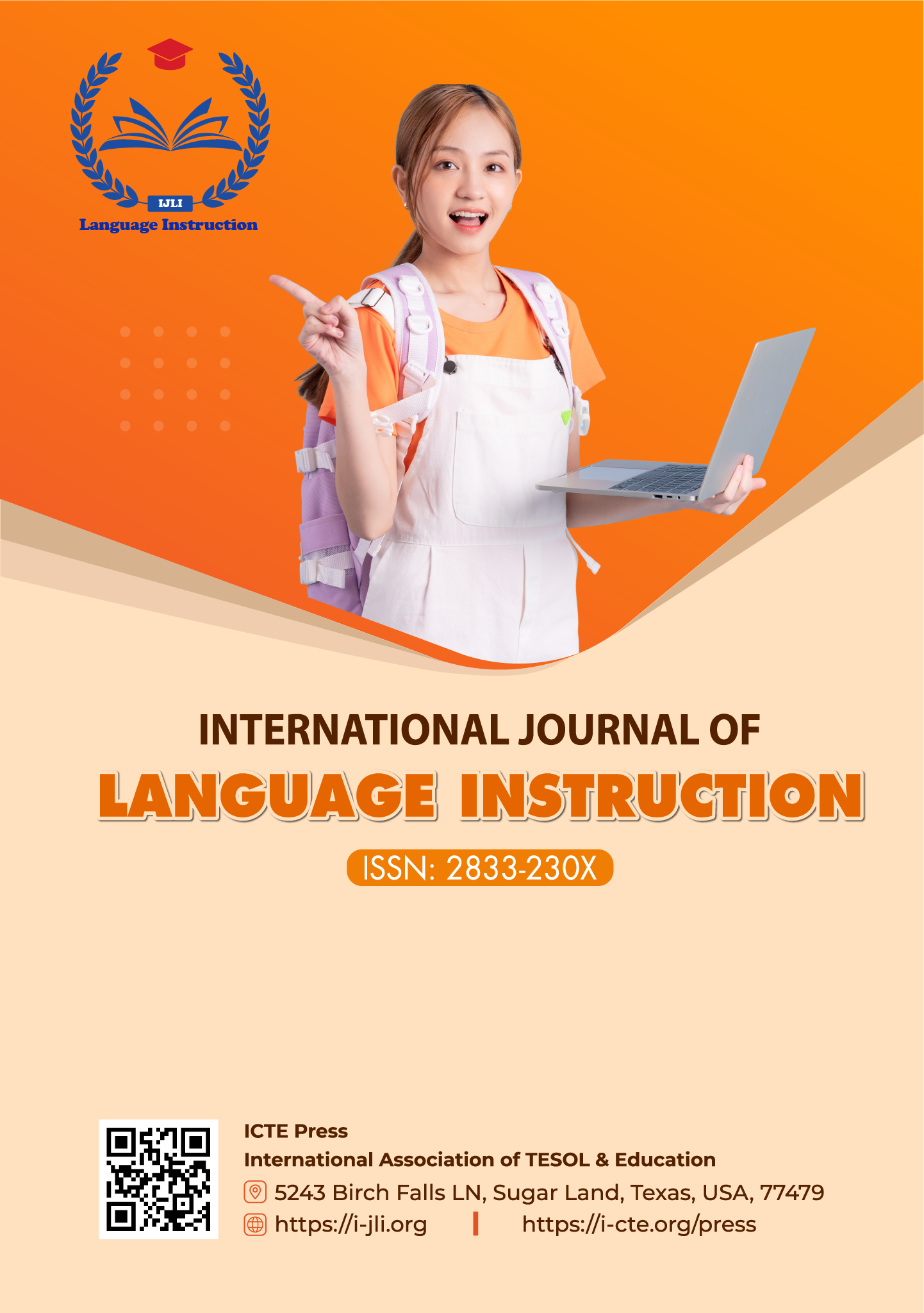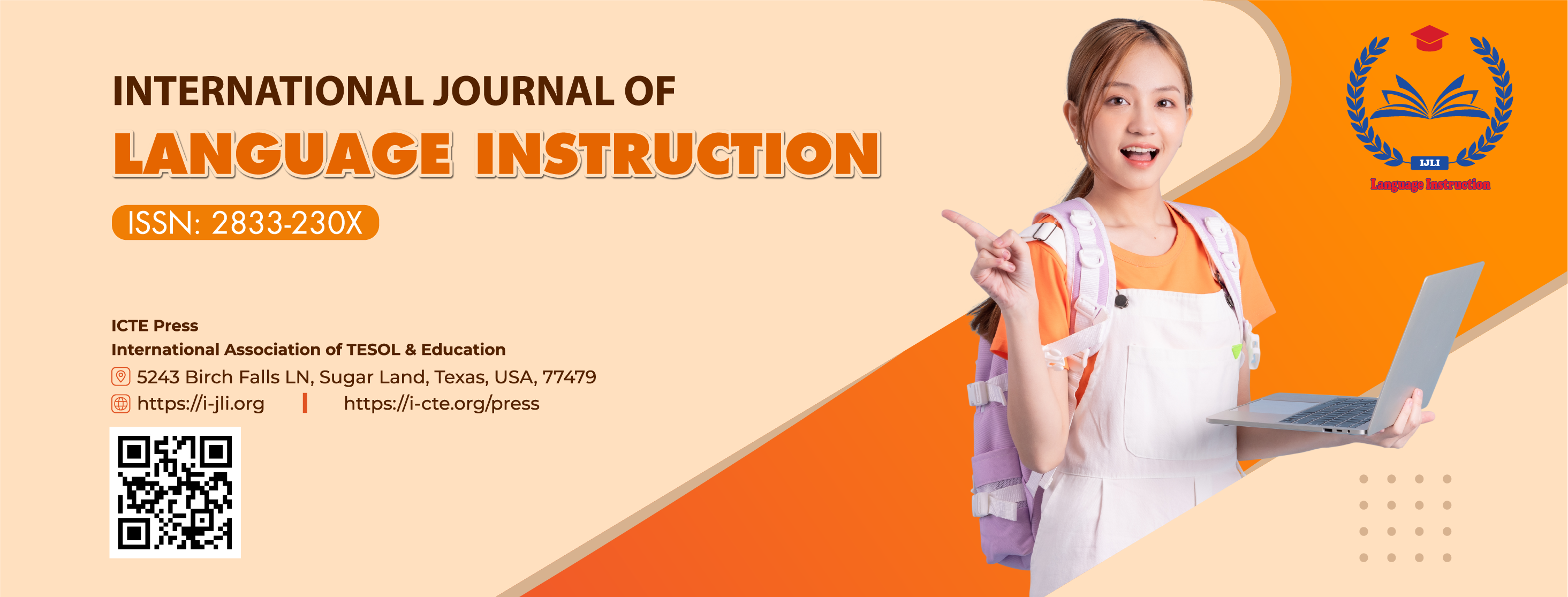Exploring the Challenges of Learning English as a Second Language in Somaliland
DOI:
https://doi.org/10.54855/ijli.25436Keywords:
Language Learning, Language Barriers, Teaching MethodsAbstract
English language learning remains a significant challenge in Somaliland despite years of formal instruction across various educational settings. This study investigates the persistent difficulties experienced by English learners, focusing on students at Moon College, one of the well-known English institutions in Hargeisa. It aims to explore why students continue to struggle with English proficiency even after extended exposure. Using a qualitative research design, the study involved key informant interviews with eight English teachers and four focus group discussions with 24 students. Data were gathered through open-ended questions and analyzed thematically. The findings revealed three main categories of challenges: instructional barriers (such as outdated teaching methods and lack of qualified instructors), environmental factors (including limited English exposure beyond the classroom and weak support at home), and psychological obstacles (low confidence, poor motivation, and cultural reluctance to use English). Students reported difficulties in pronunciation, grammar, listening, and academic writing. Despite these challenges, some learners used platforms like Duolingo, YouTube, and Artificial Intelligence (AI) tools to improve skills. The study recommends curriculum reform, enhanced teacher development, and integration of technology in instruction.
References
Akbari, Z. (2015). Current challenges in teaching/learning English for EFL learners: The case of junior high school and high school. Procedia -Social and Behavioral Sciences, 199, 394–401. DOI: https://doi.org/10.1016/j.sbspro.2015.07.524
Alawfi, N. N. R. (2022). English language learning difficulties in Saudi Arabia: Tabuk University as a case study. مجلة وادی النیل للدراسات والبحوث الإنسانية والاجتماعية والتربویه, 33(33), 139–168. https://doi.org/10.21608/jwadi.2022.213398
Ali Adrob, H. (2021). Difficulties of third language learner in Sudan. International Journal of Languages and Culture, 1(1), 1–8. https://doi.org/10.51483/IJLC.1.1.2021.1-8
lseed, M. I. M. (2022). Speaking difficulties encountered by EFL university students: A case study of EFL students at the Faculty of Education, Elhasahisa, University of Gezira, Sudan. Diyala Journal of Human Research, 1(92), 690–699. 10.57592/djhr.v1i92.2146
Atuhura, D., & Nambi, R. (2024). Competence-based language curricula: Implementation challenges in Africa. ELT Journal. https://doi.org/10.1093/elt/ccae003
Azim, Y. (2025). Teaching English in sub-departments: Challenges and solutions. Journal of Social Sciences - Kabul University. https://doi.org/10.62810/jss.v3i2.254
Castillo, J. (2023). The power of language and the language of power: Sociolinguistic methods and social histories of language and political power in Mobutu’s Congo-Zaire (1965–1997). History in Africa, 50, 7–39. https://doi.org/10.1017/hia.2022.13
Castleberry, A., & Nolen, A. (2018). Thematic analysis of qualitative research data: Is it as easy as it sounds? Currents in Pharmacy Teaching and Learning, 10(6), 807–815. https://doi.org/10.1016/j.cptl.2018.03.019
Chemir, S., & Kitila, T. (2022a). English for academic purposes learners' needs analysis: Language difficulties encountered by university students in Ethiopia. Celtic: A Journal of Culture, English Language Teaching, Literature and Linguistics, 9(1), 97–119. https://doi.org/10.22219/celtic.v9i1.20646
Chemir, S., & Kitila, T. (2022b). Learners’ needs analysis for English for academic purposes in Ethiopian higher education institutions: The case of Wachemo University freshman students. Cogent Education, 9(1), Article 2026190. https://doi.org/10.1080/2331186X.2022.2026190
Cohen, C., & Quirk, E. (2025). The role of environmental factors on grammatical development in French–English bilinguals attending a dual language programme in France. Languages. https://doi.org/10.3390/languages10010006
de Galbert, P. G. (2023). Language transfer theory and its policy implications: Exploring interdependence between Luganda, Runyankole-Rukiga, and English in Uganda. Journal of Multilingual and Multicultural Development, 44(1), 1–19. https://doi.org/10.1080/01434632.2020.1788038
Dehghanzadeh, H., Fardanesh, H., Hatami, J., Talaee, E., & Noroozi, O. (2021). Using gamification to support learning English as a second language: A systematic review. Computer Assisted Language Learning, 34(7), 934–957. https://doi.org/10.1080/09588221.2019.1648298
Di Carlo, P. (2018). Towards an understanding of African endogenous multilingualism: Ethnography, language ideologies, and the supernatural. International Journal of the Sociology of Language, 2018, 139–163. https://doi.org/10.1515/IJSL-2018-0037
Elbashir, E. (2022). The problems of fluency in spoken English among EFL learners in Sudanese universities. Journal of English Language Teaching and Applied Linguistics, 4(4), 14–17. https://doi.org/10.32996/jeltal.2022.4.4.3
Garaeva, U. (2024). Psychological barriers in learning English. Scientific and Technical Creativity of Youth – 2024. Proceedings of Russian Scientific and Technical Conference. https://doi.org/10.55648/nttm-2024-1-27
Ghaffar, A., Abdellatif, M. S., Almusharraf, N., & Imran, M. (2024). Teachers’ perspectives on effective English language teaching practices at the elementary level: A phenomenological study. Heliyon, 10(8), e29175. https://doi.org/10.1016/j.heliyon.2024.e29175
Gobena, G. A. (2025). Psychological barriers contributing to students’ poor English language speaking skills. International Journal of Instruction, 18(1), 16–29. https://doi.org/10.29333/iji.2025.18115
Haufiku, I., Mashebe, P., & Abah, J. (2022). Teaching challenges of English second language teachers in senior secondary schools in the Ohangwena region, Namibia. Creative Education, 13(6), 1941–1964. https://doi.org/10.4236/ce.2022.136129
Hillman, S., Selvi, A. F., & Yazan, B. (2020). A scoping review of world Englishes in the Middle East and North Africa. World Englishes, 40(2), 159–175. https://doi.org/10.1111/weng.12505
Hoque, M. S., Oli, L., Thamarai Selvi, M., Chowdhury, A. S. M. M. H., & Reza, M. M. (2024). Untangling the tongues: Exploring pronunciation development strategies for learners of English at high schools in Oromia region of Ethiopia. World Journal of English Language, 14(5), 257–257. https://doi.org/10.5430/wjel.v14n5p257
Jelokbuso, P. (2025). Analyzing students' internal problems in learning English. Al Qodiri: Jurnal Pendidikan, Sosial dan Keagamaan, 23(1), 16–29. https://doi.org/10.53515/qodiri.2025.23.1.16-29
Kanwal, R., Hussain, M. S., & Farid, A. (2022). Second language acquisition (SLA) and bilingualism: Impact of mother tongue on English as a second language (ESL) learners. Research Journal of Social Sciences and Economics Review, 3(3), 100–111. https://doi.org/10.36941/rjss-2022-0031
Khoeroni, F., Wahyuningsih, S., Afandi, M., & Kasriyati, D. (2023). Barriers to teaching English to non-native English-speaking teachers in Indonesian secondary schools: Policy recommendations. European Journal of Educational Research, 12(4), 1617–1627. https://doi.org/10.12973/eu-jer.12.4.1617
Kithinji, W. K., & OHirsi, A. I. (2022). Relating English language proficiency to academic performance among non-English speaking undergraduate students in Kenyan universities. East African Journal of Education Studies, 5(1), 66–76. https://doi.org/10.37284/eajes.5.1.101
Lumala, M., & Mullany, L. (2020). Language, gender and leadership: Applying the sociolinguistics of narrative and identity in East Africa. In Language, Gender and Leadership (pp. 65–88). Springer. https://doi.org/10.1007/978-3-030-41668-3_4
Madden, N. O., Gordon, S., Chambers, R., Daley, J.-L., Foster, D., & Ewan, M. (2025). Teachers’ practices and perceptions of technology and ChatGPT in foreign language teaching in Jamaica. International Journal of Language Instruction, 4(2), 1–32. https://doi.org/10.54855/ijli.25421
Mandal, R. (2024). Influence of home environment on students’ achievement in English: A systematic literature review. RESEARCH REVIEW International Journal of Multidisciplinary, 9(10), 9–16. https://doi.org/10.31305/rrijm.2024.v09.n10.009
Mazrui, A., & Mazrui, A. (1993). Dominant languages in a plural society: English and Kiswahili in post-colonial East Africa. International Political Science Review, 14(3), 275–292. https://doi.org/10.1177/019251219301400305
Melesse, T., & Obsiye, F. A. (2022). Analysing the education policies and sector strategic plans of Somaliland. Cogent Education, 9(1), 2152545. https://doi.org/10.1080/2331186X.2022.2152545
Mohamed, M. A. A. (2024). Investigating the effect of reading English short stories in developing skills for EFL students at some selected universities in Mogadishu, Somalia. SERDEC Educational Research and Development Centre, 5–15. https://doi.org/10.29333/serdec.2024.0515
Mohammed, M. H. (2018). Challenges of learning English as a foreign language (EFL) by non-native learners. International Journal of Social Science and Economic Research, 3(4), 1381–1400. https://doi.org/10.5281/zenodo.1473635
Muftah, M. (2024). Impact of social media on learning English language during the COVID-19 pandemic. PSU Research Review, 8(1), 211–226. https://doi.org/10.36941/psur-2024-0008
Nosirova, D. (2023). Learning English as a second language: Challenges and strategies. Modern Science and Research, 2(9), 165–170. Retrieved from https://inlibrary.uz/index.php/science-research/article/view/24086
Obaid, B., & Abdullah, L. (2023). Challenges faced by Saudi English language learners in the UK: An action research approach to enhancing intercultural communication. Bulletin of The Faculty of Languages & Translation, 25(2), 135–176. https://doi.org/10.21608/bflt.2023.319525
OHirsi, A., Mwirichia, S., & Kanyi, C. (2022). Students' attributes influence on the adoption of the English language as a medium of instruction at Somali National University. African Journal of Emerging Issues, 4(8), 41–51. Retrieved from https://ajoeijournal.org/sys/index.php/ajoei/article/view/317
Opare-Kumi, J. (2024). English medium instruction in multilingual contexts: Empirical evidence from Ethiopia. International Journal of Educational Development, 105, 102987. https://doi.org/10.1016/j.ijedudev.2024.102987
Prabawati, A., St Asriati, A. M., & St Asmayanti, A. M. (2021). The students’ perception of the online media used by teacher in learning English. English Language Teaching Methodology, 1(3), 169–181. Retrieved from https://jurnal.fkip.unismuh.ac.id/index.php/eltm/article/view/49
Roemer, A. E. (2024). Second language acquiescence of multilingual students in Tanzania. Language and Education, 38(2), 269–285. https://doi.org/10.1080/09500782.2023.2186792
Rosita, A. (2024). Students' psychological problems in English speaking performance. ELP (Journal of English Language Pedagogy), 9(2), 132–140. https://doi.org/10.36665/elp.v9i2.918
Rustamov, I., & Mirza ogli, A. I. (2023). The importance of listening and speaking in learning English. Журнал иностранных языков и лингвистики, 5(5). Retrieved from https://fll.jdpu.uz/index.php/fll/article/view/7881
Sultana, Z., & Imran, M. (2024). Challenges faced by English teachers in Pakistan. Spry Journal of Literature and Linguistics, 2(1). https://journals.sprypublishers.com/index.php/Journal-of-Literature-and-Lingui/article/view/35
Tai, K. W., & Zhao, Y. V. (2024). Success factors for English as a second language university students’ attainment in academic English language proficiency: Exploring the roles of secondary school medium-of-instruction, motivation and language learning strategies. Applied Linguistics Review, 15(2), 611–641.
Taye, T., & Mengesha, M. (2024). Identifying and analyzing common English writing challenges among regular undergraduate students. Heliyon, 10(17), Article e36876. https://doi.org/10.1016/j.heliyon.2024.e36876
Thach, N. M. L. (2025). The impact of extroversion and introversion on EFL students’ second language acquisition. International Journal of Language Instruction, 4(2), 80–93. https://doi.org/10.54855/ijli.25424
van Nes, F., Abma, T., Jonsson, H., & Deeg, D. (2010). Language differences in qualitative research: Is meaning lost in translation? European Journal of Ageing, 7(4), 313–316. https://doi.org/10.1007/s10433-010-0168-y
Wisrance, M. W., & Kristanti, E. (2024). Psychological barriers on EFL students’ speaking performance in border area. EXPOSURE: Jurnal Pendidikan Bahasa Inggris, 13(2), 413–430. https://doi.org/10.26618/exposure.v13i2.15634
Wolff, H. E. (2016). Language and development in Africa: Perceptions, ideologies and challenges. Cambridge University Press. https://doi.org/10.1017/CBO9781316105023
Zhang, X., Lau, C., & Su, Y. (2021). Home environment and development of English as a second/foreign language for young children in Asian contexts: A systematic review and meta-analysis. Early Education and Development, 34, 274–305. https://doi.org/10.1080/10409289.2021.1981065
Downloads
Published
Issue
Section
License
Copyright (c) 2025 Abdulaziz Bashir Abdi

This work is licensed under a Creative Commons Attribution 4.0 International License.
The copyright of all articles published in the International Journal of Language Instruction (ijli) remains with the Authors, i.e. Authors retain full ownership of their article. Permitted third-party reuse of the open access articles is defined by the applicable Creative Commons (CC) end-user license which is accepted by the Authors upon submission of their paper. All articles in the ijli are published under the CC BY-NC 4.0 license, meaning that end users can freely share an article (i.e. copy and redistribute the material in any medium or format) and adapt it (i.e. remix, transform and build upon the material) on the condition that proper attribution is given (i.e. appropriate credit, a link to the applicable license and an indication if any changes were made; all in such a way that does not suggest that the licensor endorses the user or the use) and the material is only used for non-commercial purposes.
Authors are able to enter into separate, additional contractual arrangements for the non-exclusive distribution of the journal's published version of the work (e.g., post it to an institutional repository, in a journal or publish it in a book), with an acknowledgment of its initial publication in this journal.











